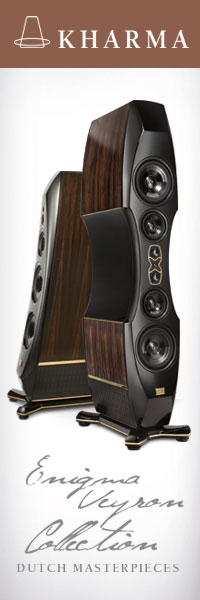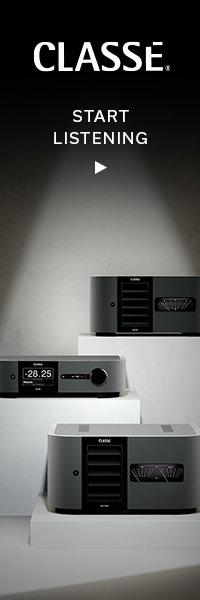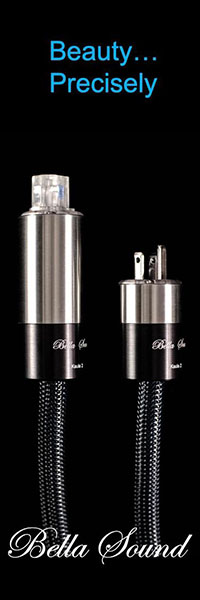Quantum Life Symphony A/C Powerline Conditioner
| Clement Perry |
| 17 August 1999 |

Distributor: Quantum Life Products
Type: Line Conditioner
Price: $300 each
Operating Voltage: One External 9-Volt DC Adapter
Dimensions: 5.5″ W × 5″ D × 1.5″ H
Weight: 1.5 lbs.
Address: 943-A Euclid Street.
Santa Monica, CA 90403
Phone: 800/809-5480
Phone: 310-394-4488
Fax: 310-859-5563
E-mail: quantmlif@aol.com
“Protecting your incoming audio circuitry’s DC supply voltages is a host of rectifiers, transformers, voltage regulators, filters, capacitors, and diodes. With all this, it becomes difficult to be persuaded that pre-conditioned AC can influence an audio system’s sound.”
Power line conditioners are supposedly designed to treat your AC line by ridding it of incoming Radio Frequency Interference (RFI), ElectroMagnetic Interference (EMI), grunge, and impurities. Simultaneously, they’re designed to protect your hard-earned components from power surges and, at the same time, maintain a steady voltage. Correct? I’ve owned my share of power line conditioners, dating back to the days when the Tripplite 2400 was among the more popular brands. Counterpoint also sold the PAC-5, which I also tried with exactly the same results: They softened the bass and truncated the highs!
These were the simple types, made merely of series inductors. Considering that they were indeed better than going straight out of the wall, I sort of became accustomed to the idea that this is the way line conditioners worked. Eventually, I’d graduate to the larger, heavier units, boasting isolation transformers, which offered some improvement in performance, albeit minor, considering their cost. It seemed that the bigger the claims, the bigger the cost. I continued to lowbrow each new product touting entrance to heaven’s front door.
Consider this: With amplifier circuitry being as elaborate, these days, as it appears when reading any (components) power supply’s schematic, one should guess that no AC artifacts should ever be of any major cause or concern. Your typical AC cord feeds into a sophisticated audio creation that ensures the DC supply is stable and isolated from the electrical gremlins that thrive behind your wall socket. Protecting the DC supply voltages of your incoming audio circuitry involves a host of rectifiers, transformers, voltage regulators, filters, capacitors, and diodes. With all this, it becomes difficult to be persuaded that pre-conditioned AC can influence an audio system’s sound.
A Change Is Gonna Come
Recently, I’ve noticed a considerable change in what’s expected of AC line conditioners. The brick-wall products worked very well in terms of making the system sound overall superior compared to the one without them, especially in the bass. Another fascination, of late, has been the Tara Labs Power Screen line conditioner. This baby cleans the AC, as well as adding sparkle to the top end. But none of these products matched the performance of the latest line conditioner from Quantum Life Products, the Symphony AC Line Conditioner.
Similar to Quantum Mechanics’ technology, as exemplified by Jack Bybee’s claim to fame (Tara’s products also incorporate a portion of this technology in their newest products), the technology employed in the Symphony is based on processing the behavior of electrons in electrical conductors at an atomic level. Bill Stierhout, Quantum Symphony’s distributor and an engineer himself, explained his theory during one of many lengthy phone conversations. “The Symphony’s designed to make coherent the random, chaotic motion of electrons in the components of the circuit design. Once made coherent, the electrons remain that way.” With this theory in mind, Bill discussed its advantages. “A synergism between the atoms of the house wiring (and of the connected electrical devices), and the electrons in the current stream flowing through them takes place. This leads to fewer inelastic scattering events of electrons along the electrical wiring path. Also, fewer helical electromagnetic photons (light) are emitted. Thus, the soothing of electrical motion results in a cleaner, purer sound-restoring the fidelity of the information carried bythe AC.”
“If the old adage “never judge a book by its cover” were ever to apply, this would be picture perfect.”
K.I.S.S. (Keep It Simple, Stupid!)
In simpler terms: Certain laws of quantum mechanics predict that if coherent electrons come into contact with the electrons in home electricity, those incoming electrons will behave coherently also. The electricity should become at once “cleaner,” and the resulting electromagnetic fields also should benefit by becoming more coherent. The effect is similar to that of an ionizer device that functions to clean an environment by eliminating odors.
To understand how these AC line products operate is not as simple as describing what they’re designed to do. What Bill alluded to was; internally the Symphony house a kind a micro processor that sends out a pulse of some sort, that treats the AC, thus preventing it from reacting in a chaotic fashion. Physically, however, the Symphonies look more akin to a Radio Shack antenna booster rather than a full-fledged AC line conditioner. Using no isolation transformers or filters at all and lacking any Hubbell-type AC receptacles makes the Symphony a simple parallel device (a first for me) and quite easy to grade. The front panel features a company logo, unit name, and a green LED power-on display, while the rear panel houses only the input receiver for the 9-volt adapter. I was shipped two units and found this to be ideal due to the current load, as well as the usage of multiple amplifiers in my Home Theatre application. Therefore, I recommend buying two. As it’s so small and simple compared to the competition, one might question its ability to perform like a true line AC conditioner. Forget about out-performing my reference 40 lb. Marigo Reference! The Symphonies came in a (5.5″ by 5″ by 1.5″) black encased metal chassis equipped with a detachable 9-volt DC adapter that gave it a relatively cheap UN-audiophile feel. It simply appears too light, in terms of weight, size, and sophistication, to live up to all the company’s claims. If the old adage “never judge a book by its cover” were ever to apply, this would be picture perfect. Here’s why.
“I found myself playing CD’s all night long, never running out of music to marvel the noteworthy differences revealed through the Symphonies.”
My system is still mainly composed of the very same products, namely: The now orphaned Von Schweikert VR6 loudspeaker. The Meitner Bidat D to A, and Meitner transport. The Z-Systems RDP-1 Digital Equalizer sandwiches these two units. The cable is still the amazing Harmonic Tech Pro 9 speaker cable (shotgunned), and the Pro Silway Mk II Interconnects. The newest unit to join my system recently is the Sim Audio W-10 Monos. These babies have turned out to be nothing short of astonishing in terms of neutrality and harmonic integrity. This amp could very well become the best solid-state amplifier to have graced my listening room. The Argent Room Lens is still incredible, as well as the Bybee’s, the TDS (True Dimensional Sound), and the Audio Harmony (review forthcoming).
The TDS, as well as the Bybees, were removed from the system for this review.
Returning to the Symphonies, the unit is designed to be used in parallel with your system, allowing for a quick and easy hookup. I installed my two directly into the Marigo’s open receptacle and directly into the wall, parallel to the Marigo power plug, in less than one minute. I listened to the system for about two hours beforehand to stabilize my bearings. The first disc up was a favorite: “Dedication to James W. Clark” from the Pharoah Sanders CD entitled A Prayer Before Dawn (ECD 22047-2). Just a few minutes into the piece I knew something very special had in fact occurred but it was very difficult to put a finger on it. (The manufacturer states a two-minute burn-in period.) This disc certainly took on a different signature. Hallelujah!
First impressions; somehow, the sound had become louder on its own. Despite this apparent increase in volume, the treble hardness had decreased considerably, yet it had also become much clearer. The treble transients in the cymbals on this spirited and moving track lost that last bit of bite almost immediately and instead were replaced by a startlingly more palpable shimmer. Pharoah’s sensually soothing sax sounded more at ease, harmonically sweeter and tonally purer, as if his instrument was reconstructed out of more complex fundamental notes. Weird? Yes! But I began to gauge where Symphonies began to transform my system’s performance:
Three-Dimensionality.
Instruments were rendered in a much greater acoustic envelope, improving soundstage, depth, and dimensionality. 3-D imaging and localization have never been more splendid, both laterally and in the front-to-rear view.
Treble Purity &Transients.
The top end sounds silkier, emerging from a denser, blacker backdrop, which significantly improves the liquidity of the entire musical presentation.
Illustrate Please.
Cymbals, formerly reticent, seemed infused with more life, appearing almost illuminated, in stark contrast to a jet-black velvety backdrop. This provided the system with a much better sense of focus, speed, detail, and clarity at the low end. Spatial acuity, already superb, revealed an even greater “acoustic presence.” Briefly put, bass heft, definition, and articulation all improved. I found myself playing CDs all night long, never running out of music to marvel at the noteworthy differences revealed through the Symphonies. In a word….spooky.
Removing the Symphonies from the system was easily accomplished — you merely disconnect the power cord adapter. This quickly revealed less clarity (reminiscent of San Fransico’s five o’clock fog, no less). Harmonic integrity took a back seat, further reducing the inner silence. Somehow, I lost grasp of Pharoah’s meaning through his many ’Trane-like wailings and phrasings (as only he can). Feeling now somehow further removed from this recording, I found myself again closer to what’s described as a typical great-sounding hi-fi system. I don’t want hi-fi. I want music, dammit! I had to reinstall the Symphonies.
“The Quantum Symphony does to a system’s overall clarity and transparency what going to the mountains does for viewing the night sky. The blacks get blacker, while the high’s sparkle.”
I switched over to Manfredo Fest’s latest disc, entitled Just Jobim (dmpCD524), recorded in true DSD by audio guru Tom Jung. From the very first note, it became quickly evident that the Symphonies were providing a very generous lift to this disc’s already incredible articulation, transparency, and delicacy. This beautiful recording was done at Sony Studios in New York City, and I witnessed this event as a guest of Ed Meitner (Meitner’s the chief consultant on Sony’s new DSD technology due here this fall). Attending this session was a wonderful, enlightening occasion I’ll soon not forget. Listening to its improvements through the Symphonies provided an unforgettable experience on its own. At once, all indications of this disc being played by a stereo system were significantly reduced. If my memory serves me correctly, Manfredo’s piano never sounded more natural, in the way live music sounds.
Conclusions
Ever attempt to see the stars in the night sky from any big city? Don’t even try. First off, there are way too many lights, and God knows what else is polluting your view. But take a hike up to the country, and you’ll see a huge difference. The sky’s blacker, cleaner, while the stars appear closer, glistening with sparkles of light. If you stare long enough, you’ll think you’re standing among them.
The Quantum Symphony enhances a system’s overall clarity and transparency, much like going to the mountains does for viewing the night sky. The blacks get black as the night’s sky, while the highs twinkle like stars. Listen for a while and you’ll think you’re standing among the performers. The Quantum Symphony Line conditioner is a wonderful product worthy of the highest praise. It is not like other AC line conditioners, offering an incredible array of features such as RFI and EMI suppression, surge protection, voltage regulation, and multiple receptacles. It does something altogether different, and I must admit, stimulating. It is designed simply as a parallel device to be used as is or in conjunction with your existing AC line conditioner. As of this moment, the Symphonies are easily the best AC line conditioners to have graced my system. Do yourself a favor and go hear a Symphony!
![]()
Don’t forget to bookmark us! (CTRL-SHFT-D)
Stereo Times Masthead
Publisher/Founder
Clement Perry
Editor
Dave Thomas
Senior Editors
Frank Alles, Mike Girardi, Russell Lichter, Terry London, Moreno Mitchell, Paul Szabady, Bill Wells, Mike Wright, and Stephen Yan,
Current Contributors
David Abramson, Tim Barrall, Dave Allison, Ron Cook, Lewis Dardick, John Hoffman, Dan Secula, Don Shaulis, Greg Simmons, Eric Teh, Greg Voth, Richard Willie, Ed Van Winkle, Rob Dockery, Richard Doron, and Daveed Turek
Site Management Clement Perry
Ad Designer: Martin Perry





Be the first to comment on: Quantum Life Symphony A/C Powerline Conditioner